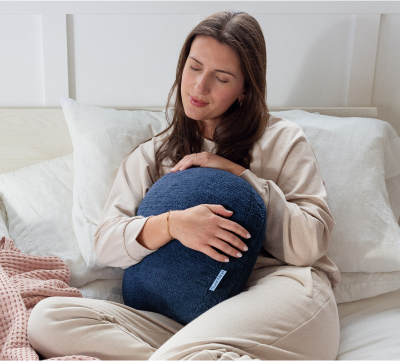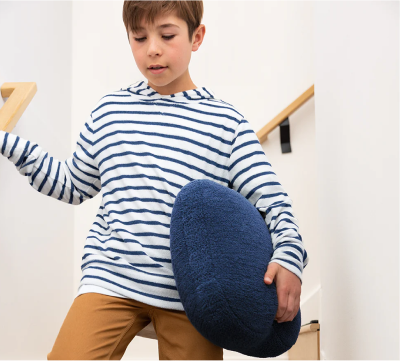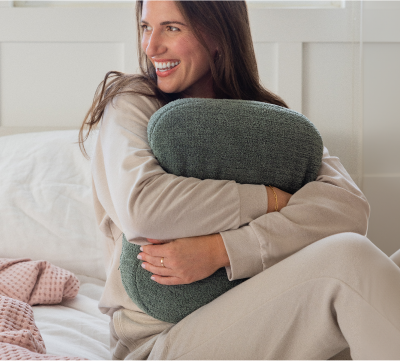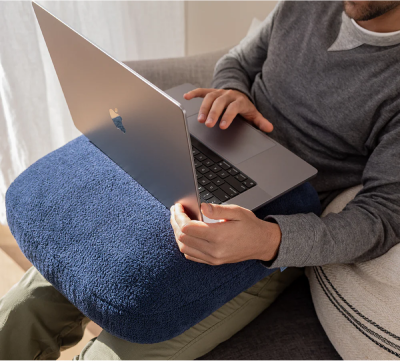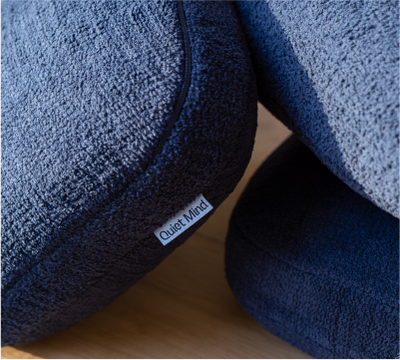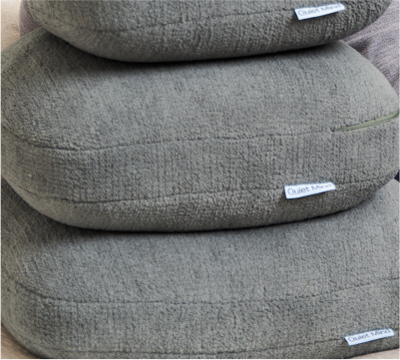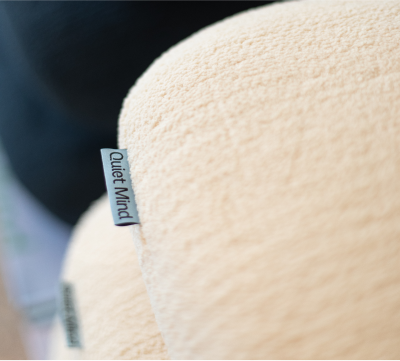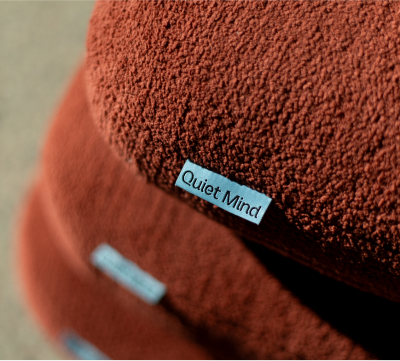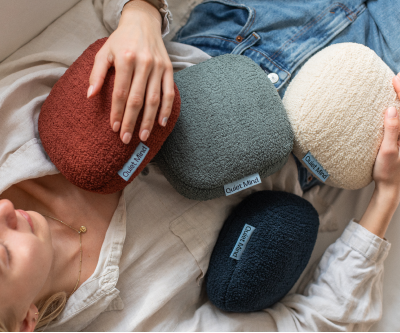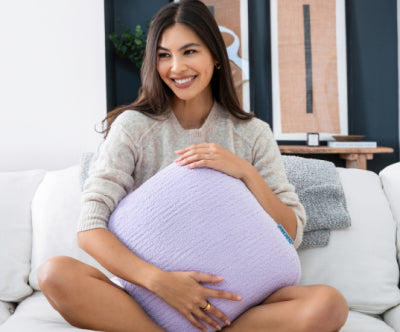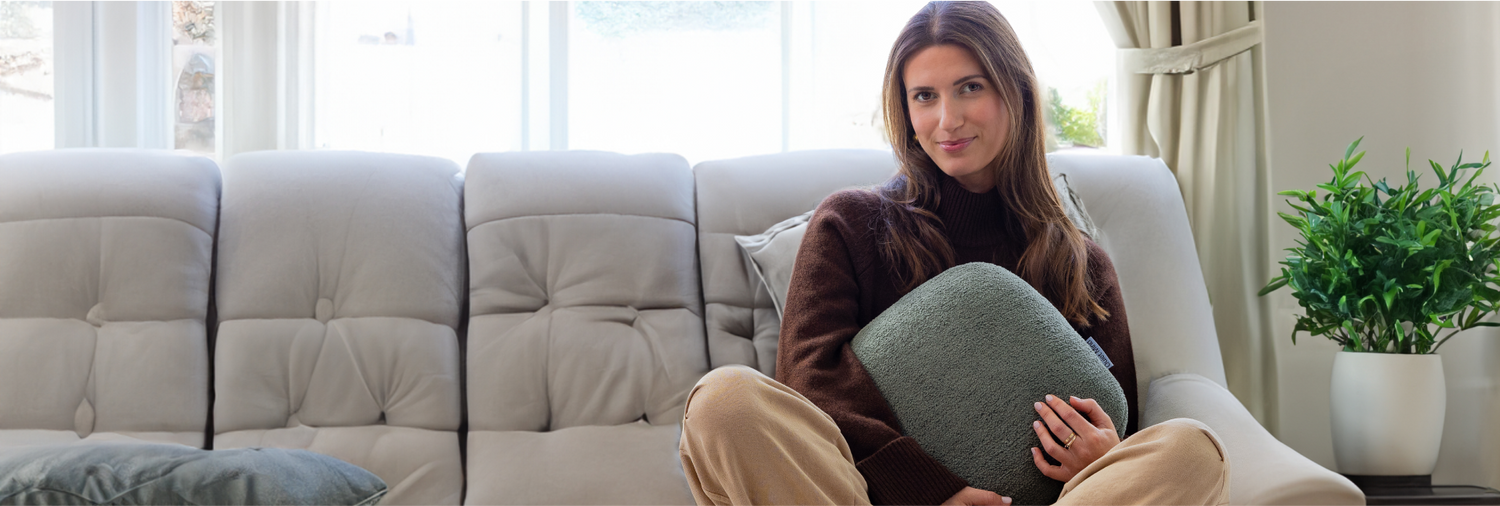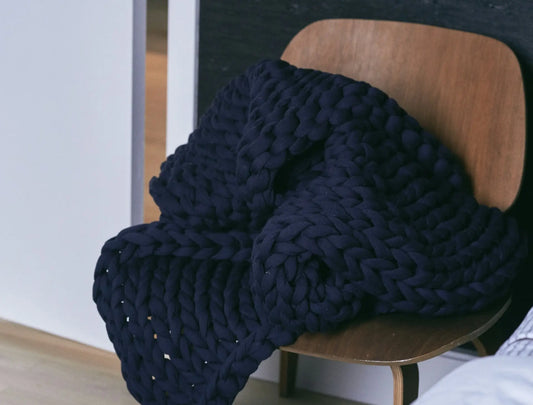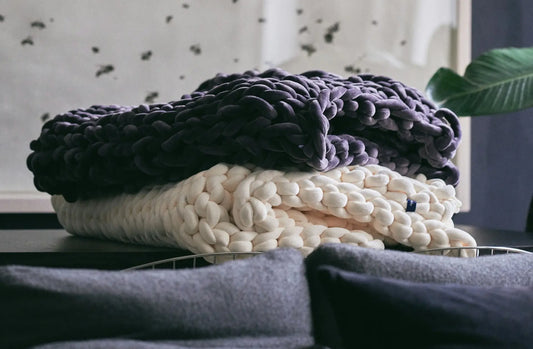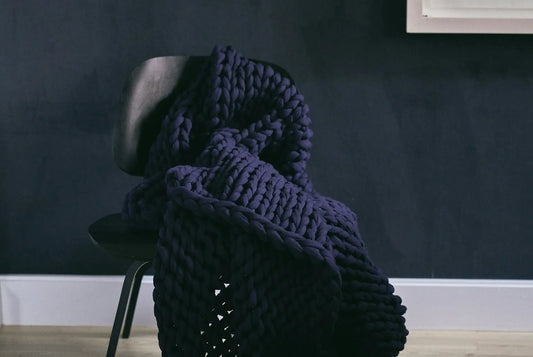There’s a quiet kind of comfort in stillness. A sense of safety in subtle pressure—like a grounding hand on your chest reminding you to soften, to breathe, to let go. Weighted pillows offer that kind of support. Not loud. Not overwhelming. Just present.
At QuietMind, we design weighted pillows to feel like an anchor for your nervous system. A companion that helps you regulate stress, ease restlessness, and reconnect with calm—without trying harder.
In this guide, you'll learn what a weighted pillow is, how it works, and how it may help ease anxiety, improve sleep, and support sensory needs. You'll also discover how to choose one that fits your body and your rhythm.
What Is a Weighted Pillow?
A weighted pillow is a soft, portable cushion filled with heavy materials such as glass beads or poly pellets. It’s smaller than a weighted blanket and designed for localized use—across the chest, on the lap, behind the neck, or along the spine.
The key feature is deep touch pressure: steady, evenly distributed weight that mimics the feeling of a firm hug or a hand on your back. This kind of sensory input may help the body downshift from “fight or flight” mode into rest and regulation.
Quiet Mind’s signature weighted pillow was designed with this in mind: a portable source of steady pressure, intentionally crafted for daily use—not just bedtime.
How Weighted Pillows Work: Deep Pressure and the Nervous System
Weighted pillows work through a calming method called deep pressure stimulation (DPS). This technique uses gentle, consistent pressure to activate the parasympathetic nervous system—the part responsible for rest, digestion, and recovery.
When your body senses deep touch pressure, it may trigger:
- A reduction in cortisol (the stress hormone)
- An increase in serotonin and dopamine (linked to mood and stability)
- Improved melatonin production (important for sleep)
This isn’t just theoretical. Studies have found that weighted tools like blankets can reduce symptoms of anxiety, improve sleep quality, and support emotional regulation in both children and adults, including those with autism spectrum disorder, ADHD, and sensory processing disorder.
Just as a weighted blanket covers the body to offer full-body pressure, a weighted pillow targets specific areas. Because of their focused design, weighted pillows can be beneficial for those who prefer lighter, more localized pressure.
Clinical Backing and Citations for Deep Pressure Therapy
Weighted pillows apply a sensory technique known as deep pressure stimulation (DPS), which may help the nervous system shift into a calmer, more regulated state. While most existing research focuses on weighted blankets and vests, the findings suggest that similar benefits may extend to weighted pillows as well.
These include reduced anxiety, improved sleep quality, and better emotional regulation. This section highlights the research behind these tools and their therapeutic applications.
What is Deep Pressure Stimulation?
DPS involves applying consistent, gentle pressure across the body. It mimics the sensation of a firm hug or a hand on the back—activating the parasympathetic nervous system and encouraging the body to shift from alertness to relaxation.
Evidence from Peer-Reviewed Studies
- A 2015 study in the Journal of Sleep Medicine & Disorders showed that a weighted blanket increased sleep time and reduced nighttime movement in adults with insomnia.
- Early reports in Occupational Therapy in Mental Health and AOTA resources noted that weighted vests were used to ease anxiety and self-stimulatory behaviors in children with autism, but more recent reviews call for stronger evidence.
- A study in the American Journal of Occupational Therapy found weighted vests improved on-task behavior by 18–25% in students with attention challenges, supporting their use as deep-pressure regulation tools.
Use in Therapeutic Practice
Occupational therapists frequently incorporate weighted pillows and lap pads into sessions. These tools are used to:
- Help clients manage overstimulation
- Reinforce sensory input during transitions
- Encourage focus and calm in children and adults alike
Weighted Pillow vs. Weighted Blanket: What’s the Difference?
|
Feature |
Weighted Pillow |
Weighted Blanket |
|
Size & Use Area |
Small, localized (chest, lap, neck) |
Full body coverage |
|
Portability |
Easy to move and travel with |
Bulkier and less mobile |
|
Application |
Short-term or daytime use |
Primarily for sleeping |
|
Weight Range |
Usually 3 to 12 pounds |
Typically 5 to 30 pounds |
|
Versatility |
Desk, couch, car, meditation, bedtime |
Mostly bedroom |
|
Great For |
ADHD, autism, workplace tension, quick calming |
Sleep support, anxiety, nighttime rest |
A weighted pillow can be helpful if you don’t want the full pressure of a blanket, but still want to experience the benefits of deep touch pressure. Think of the QuietMind pillow as a more adaptable tool—small enough to carry, strong enough to ground you when things feel too much.
Who Can Benefit from a Weighted Pillow?
Weighted pillows support many people, especially those navigating conditions where sensory input, rest, or emotional regulation can be a challenge.
Children and Adults with ADHD
The gentle weight of a pillow may provide sensory feedback that helps improve attention, focus, and self-soothing. Some people with ADHD use weighted pillows during work or school to calm fidgeting or racing thoughts.
Individuals on the Autism Spectrum
Deep touch pressure works effectively for individuals with autism spectrum disorder by helping to calm sensory overload.Weighted pillows offer a more flexible option than weighted blankets or vests, particularly for daytime transitions or quiet routines.
People with Anxiety or High Stress
The effectiveness of weighted pillows in reducing anxiety lies in their calming, non-invasive presence. They may help the body down-regulate from chronic tension and feel more grounded, especially during stressful periods or nighttime worry.
Sleep Struggles and Restlessness
Whether you experience insomnia, disrupted sleep, or have difficulty relaxing before bed, the gentle pressure of a weighted pillow can signal to the body that it’s safe to rest. It may help with conditions such as restless leg syndrome by providing steady tactile input.
Sensory Seekers and Highly Sensitive Individuals
For those who benefit from tactile comfort, the use of a weighted pillow offers subtle, reliable input—without overstimulation. It’s a supportive tool for moments of dysregulation, overwhelm, or even emotional shutdown.
When and How to Use a Weighted Pillow
You don’t have to “get used to sleeping” with a weighted pillow for it to work. It’s flexible, intuitive, and can be incorporated into daily life in small, meaningful ways.
Daily Wind-Down Routines
You can use your weighted pillow:
- While reading or journaling before bed.
- During evening screen-free time to help shift into rest.
- As part of your sleep routine—across the chest or hugged to the body.
At Work or School
A weighted pillow placed behind the lower back, on the lap, or under the desk can:
- Reduce fidgeting or restlessness.
- Provide postural support.
- Promote a sense of calm during focused work.
During Meditation or Breathwork
Many use weighted pillows to deepen mindfulness by:
- Placing the pillow across the lap or chest.
- Pairing it with slow breathing or a body scan.
- Creating a gentle reminder to return to the body when the mind wanders.
During Overwhelm or Sensory Overload
A weighted pillow can be a regulation tool during meltdowns or high emotional stress, especially for people with ADHD, anxiety, or autism. Used during transitions, before appointments, or in crowded environments, it may help reduce stress and anxiety through sensory grounding.
How Weighted Pillows Complement Therapy or Neurodivergent Routines
Weighted pillows are increasingly being integrated into therapy settings and neurodivergent care routines. From occupational therapy to classroom accommodations, these tools serve as practical sensory aids that help individuals regulate emotional and physical responses in real time.
Occupational Therapy Applications
Therapists often use weighted pillows in sensory integration therapy to:
- Improve body awareness
- Reduce sensory-seeking or avoidant behaviors
- Support transitions between activities
Classroom and Learning Environments
Teachers and caregivers use weighted pillows to:
- Anchor children with ADHD or SPD during desk work
- Reduce anxiety during group activities
- Support emotional regulation through calm-down corners
Incorporation into Emotional or Behavioral Therapy
In CBT, DBT, or mindfulness-based practices, weighted pillows can:
- Provide grounding during intense emotional work
- Encourage nervous system regulation while processing stress
- Help clients reconnect with bodily awareness during sessions
Weighted Pillows for Chronic Illness and Pain Management
Chronic conditions like fibromyalgia, arthritis, and chronic fatigue often bring pain, overstimulation, and trouble sleeping. Weighted pillows offer a gentle, tactile way to support comfort and regulation, especially during flare-ups or periods of discomfort. While not a cure, they can play a supportive role in daily symptom management.
Tactile Support for Pain and Fatigue
For individuals experiencing chronic pain, the steady weight of a pillow can provide soothing feedback that helps reduce tension. Whether placed behind the lower back, across the chest, or under the knees, the gentle pressure can bring relief without adding strain.
Grounding During Flare-Ups
Weighted pillows can help during pain episodes by:
- Offering sensory grounding when the nervous system feels overwhelmed
- Supporting stillness when movement is difficult
- Creating a sense of control during unpredictable pain spikes
Comfort for Bed Rest and Recovery
For those recovering from surgery or managing low-energy days:
- A weighted pillow placed across the lap or hugged to the chest can provide emotional reassurance and physical stability.
- Its subtle weight encourages relaxation, helping the body settle into rest.
Weighted Pillows for Travel and On-the-Go Regulation
Travel can be overstimulating. Whether it’s the bright lights and noise of an airport, the confined space of a car or plane, or the disruption of unfamiliar environments, transitions can challenge even the calmest routines. Weighted pillows offer a lightweight, portable source of grounding—helping your nervous system stay regulated on the move.
When to Use a Weighted Pillow While Traveling
- On planes or trains to ease travel anxiety and reduce restlessness.
- During long car rides for grounding and posture support.
- At airports or events where crowds and noise may overwhelm.
- In hotel rooms to bring a familiar calming sensation to new environments.
What Makes a Good Travel Pillow?
- Lightweight (under 5 lbs) and foldable.
- Compact size for backpacks or carry-ons.
- Durable and easy-to-clean fabric.
- Breathable cover for long use.
Support in Overstimulating Environments
Using a weighted pillow while commuting or traveling can:
- Calm sensory overload.
- Reduce fidgeting during waiting periods.
- Create a personal buffer in crowded spaces.
How to Choose the Right Weighted Pillow
The best weighted pillow is the one that feels natural in your hands, calming on your body, and easy to incorporate into your day. Below are the most important factors to consider.
1. Selecting the Right Amount of Weight
The goal is grounding, not pressure. A general rule is to choose a pillow that weighs between 3 and 12 pounds, depending on your size, strength, and sensitivity.
- 3–5 lbs: Best for children or those with a smaller frame.
- 5–8 lbs: Ideal for most adults.
- 10–12 lbs: Offers firmer pressure for deeper sensory input.
The ideal weight should feel soothing, not straining. If you’re unsure, choosing the right pillow weight can help you start with a lighter option and adjust based on your needs.
If you're shopping for children with ADHD or sensory sensitivity, check with your doctor before choosing the weight. The pillow should always be easy for them to move or remove independently.
2. Choosing the Right Shape and Size
Weighted pillows come in different forms:
- Lap pads: Great for work desks or classrooms.
- Bolster or roll shapes: Useful behind the neck or lower back.
- Standard pillow size: Ideal for hugging or placing across the chest.
Think about:
- Where you feel tension or need grounding.
- How mobile you want the pillow to be.
- Whether you'll use it for meditation, sleep, or seated work.
3. Picking the Right Material
The outer fabric and internal filling affect both comfort and care. It’s important to understand the different weighted pillow filling materials to ensure your pillow supports your needs.
Fillings:
- Glass beads: Smooth, quiet, and evenly distributed
- Poly pellets: Slightly heavier, durable
- Natural grains (flax, millet, rice): Organic feel, may have a mild scent
Covers:
- Cotton: Breathable and soft
- Bamboo: Naturally cooling and hypoallergenic
- Linen blends: Durable and texture-rich
For ease, look for a removable and washable cover—especially if you’ll be using the pillow daily.
Maintenance and Safety Considerations
Proper care and safety are essential to ensure your weighted pillow remains effective and comfortable. Here’s how to maintain its quality and use it safely.
Care Instructions
To keep your weighted pillow in good condition:
- Remove and wash the cover weekly
- Spot-clean the inner filling
- Air it out occasionally to maintain freshness
- Follow the brand’s care label to avoid damaging the seams or weight distribution
Safety Guidelines
Weighted pillows are generally safe, but some precautions are important:
- Not recommended for infants or toddlers under 2 years of age.
- Avoid placing on the chest or abdomen of someone with respiratory issues, circulatory conditions, or low muscle tone.
- If you have any health conditions or experience discomfort, consult your doctor.
The pressure of a weighted pillow should feel like a hug, not like a burden. If the weight causes pain or discomfort, switch to a lighter model.
Environmental & Ethical Benefits of QuietMind Pillows
At QuietMind, we believe calm should come with care—for your body, your space, and the environment. Our weighted pillows are designed not only to soothe, but also to support sustainability and conscious living. From filling to fabric, every element is thoughtfully sourced to align with ethical practices and long-term use.
Eco-Friendly Materials
- We use high-quality glass beads or natural fillings like flaxseed, which are reusable, long-lasting, and low-impact
- Fabric options include breathable organic cotton, bamboo, and linen blends—gentle on skin and better for the planet
Non-Toxic and Hypoallergenic Design
- All QuietMind products are free from harmful chemicals and made with sensitive users in mind
- Materials are tested for skin safety and long-term durability
Designed for Longevity, Not Waste
- Our pillows are built to be used daily, season after season
- Removable covers and durable stitching ensure extended life without early breakdown or unnecessary replacements
Weighted Pillow vs Other Weighted Tools
Here’s a breakdown to help you understand how weighted pillows compare to similar tools:
|
Tool |
Best For |
Notes |
|
Weighted Pillow |
Targeted calming, portable support |
Chest, neck, lap, or back use during day or night |
|
Weighted Blanket |
Full-body sleep support |
Not ideal for active or short-term use |
|
Weighted Vest |
On-the-go sensory input |
Often used in therapy or classrooms, adjustable fit |
|
Weighted Lap Pad |
Seated posture and attention anchoring |
Great for work desks or children with ADHD |
Weighted pillows can be used alongside these tools, or on their own, depending on your lifestyle and sensory needs.
Pairing Weighted Pillows with Other Calming Tools or Routines
Calm is often the result of small, consistent choices. When paired with other sensory tools or rituals, weighted pillows can become part of a deeply effective self-regulation practice—helping you or your child reset, unwind, or transition through stress with more ease.
Combining with Aromatherapy or Oils
- Use a weighted pillow with a calming scent like lavender to create a multi-sensory wind-down ritual.
- Essential oil rollers or diffusers work well in tandem with lap or chest placement.
Incorporating into Mindfulness Practices
- Place a weighted pillow across the lap during breathwork, meditation, or body scans.
- Use during journaling or screen-free time to reinforce stillness and present-moment awareness.
Building a Calm-Down Corner
A simple space equipped with:
- A weighted pillow
- Dim lighting or soft textures
- A favorite book or comfort item
Final Thoughts: Calm Doesn’t Have to Be Complicated
In a world full of noise, a weighted pillow offers quiet support. It doesn’t demand your full attention. It doesn’t force change. It simply sits with you—reminding your body that rest is possible.
Whether you’re exploring how to fall asleep more easily, reduce tension during the day, or support someone navigating ADHD or autism, a weighted pillow offers presence without pressure. Gentle, simple, and deeply supportive, it may become the one tool you reach for when nothing else quite helps.
It’s not about fixing—it’s about reconnecting.
About QuietMind
At Quiet Mind, we believe that rest is a human need—not a luxury. Our mission is to support your nervous system with tools that feel intuitive, grounding, and gentle on the body.
The original Quiet Mind weighted pillow was designed to meet this purpose: soft enough to soothe, weighted enough to anchor. With calming materials and ethical design, it helps you pause without pressure.
You can place it on your chest, under your neck, or across your lap—wherever your body holds tension. Whether you’re navigating sensory overwhelm, stress, or a racing mind, this pillow offers a quiet reminder to return to yourself.
Frequently Asked Questions
Are weighted pillows safe for children?
Yes—for most children over the age of 2 who can move the pillow independently. If your child has health concerns or sensory sensitivities, consult your doctor before introducing one.
Can I use a weighted pillow during sleep?
Absolutely. Many people place weighted pillows on the chest, neck, or behind the knees at night. They help improve your sleep by calming the nervous system and reducing nighttime restlessness.
What is the difference between a weighted pillow and a weighted blanket?
A weighted pillow offers targeted pressure, while a blanket covers the whole body. Pillows are better for short-term use, travel, or focused relief during the day.
How do weighted pillows help with stress or anxiety?
The steady deep touch pressure may lower cortisol (the stress hormone) and increase serotonin and dopamine—bringing calm, focus, and a feeling of comfort.
Can I use a weighted pillow if I have health conditions?
If you have respiratory or circulatory issues, or are recovering from injury or surgery, it’s important to check with your doctor before using weighted tools.
